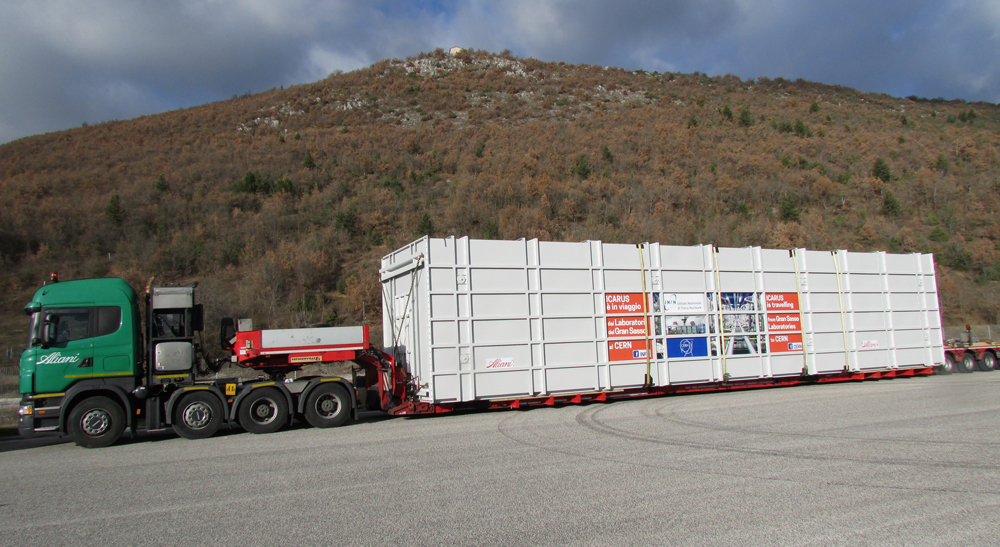
Last night ICARUS, the world’s largest liquid argon neutrino detector, left the Gran Sasso Laboratories of the Italian Institute for Nuclear Physics (INFN) and is now on its way to CERN (European Organisation for Nuclear Research) in Geneva. Since 2010, ICARUS T600 – that is its full name– has been observing the neutrino beam sent from CERN to the Gran Sasso underground Laboratories passing through 730 km of the Earth’s crust. Now ICARUS has been carefully loaded onto two special equipment transporters and is being transferred to CERN to be overhauled and upgraded, in view of its probable future use in the United States. Physicists believe it is an essential and as yet inimitable element for an experiment with low-energy neutrinos at Fermilab in Chicago. ICARUS is the only detector in the world with more than 600 tonnes of argon, and has been found to be entirely suitable. The technology of ICARUS, first proposed in 1977 by the Nobel prize winner Carlo Rubbia, who is still the spokesperson of the experiment, is an example of record-breaking performance by Italian scientists at the INFN, who have developed a unique solution. The experiment at the Gran Sasso National Laboratories has demonstrated its precision in detecting neutrinos artificially produced in an accelerator, such as those in the CNGS (CERN Neutrinos to Gran Sasso) beam, which ran from 2006 to 2012. The experiment is capable of combining the originality of the idea with technical precision and efficiency.
Technology
ICARUS T600 is a liquid argon ionization detector (600 tonnes of liquid gas). The cryogenic plant of the argon purification system and the detector’s readout electronics are unique and original, and were developed in Italy by divisions of the INFN. The technology of the detector is capable of observing ionization in neutrino processes and other rare events. The detector is entirely electronic, continuously sensitive and behaves like a huge three-dimensional camera that visualises events in a volume measuring 6 metres in width, 18 metres in length and 4 metres in height, with millimetre resolution. The principle of operation is based on the fact that in ultra-pure liquid argon, electrons released by ionizing particles can be easily transported over macroscopic distances (metres) by a uniform electric field to a multiwire anode structure placed at the end of the drift path: this structure is made of three planes of wires, three millimetres apart, which form what physicists call a “wire chamber”. The signals collected by the approximately 52,000 wires are processed by a complex electronic system to reconstruct a computer image of the subnuclear event. As Carlo Rubbia pointed out, “One of the most significant features of this technology is the highly purified liquid argon in the detector, which permits impressive results in terms of free electron lifetime, measured in parts per trillion (a trillion is a one preceded by 12 zeros) of oxygen-equivalent contamination”. The technology of ICARUS and its capabilities have thus aroused great interest among scientists for use in future experiments on short- and long-distance beams of neutrinos, such as those currently being conducted by physicists at Fermilab in Chicago. At the Gran Sasso National Laboratories ICARUS has detected several thousand neutrino events. Now it is being moved to CERN to be overhauled in preparation for important new challenges.
The journey
After leaving the INFN National Laboratories in the Gran Sasso tunnel, ICARUS had to stop at a motorway service station for a few hours to make the necessary adjustments to the articulated lorry, which had had to be lowered to bring it out of the tunnel. ICARUS will travel north up the whole of Italy, through Rome, Genoa and Turin. It will then cross the Alps through the Mont Blanc tunnel to the CERN laboratories in Geneva: the journey will take about a week.
“In the days leading up to the move, people at the Gran Sasso National Laboratory worked to make sure that the ICARUS detector could be removed as safely and smoothly as possible without damaging its valuable and delicate chamber” explained Chiara Zarra, the ICARUS movement and transportation coordinator. The layout of the underground laboratories has changed considerably since ICARUS arrived in 2000 and much of the equipment that is currently installed had to be modified. Owing to its extraordinary size, they had to take into account the presence of big new experiments and notable problems in terms of the structure of the room. We also had to take appropriate measures to guarantee the safety of the other experiments that are present: there was very little room for manoeuvring, with a clearance in the order of centimetres. The 3D simulations by the team from CERN were of fundamental importance as was the cooperation of the staff of researchers and technologists, a team of installation engineers and specialist crane operators, who presided over and supervised all stages of the operation. Its success is the result of teamwork by the LNGS and CERN and the cooperation of everyone, including other experimental collaborations, which have made it possible for the giant ICARUS detector to set off on its journey” concluded Chiara Zarra.